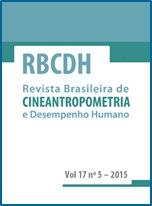Mulheres idosas com incontinência urinária apresentam menor nível de atividade física habitual
DOI:
https://doi.org/10.1590/1980-0037.2015v17n5p612Resumen
O objetivo do estudo foi verificar e comparar o nível de AF habitual com a frequência e a gravidade da perda urinária em idosas. Participaram deste estudo, 19 idosas com IU de esforço ou mista. Foram coletados dados referentes à frequência e gravidade da IU por meio do ICIQ-SF e sobre o nível de AF habitual por meio do acelerômetro triaxial GT3-X marca ActiGrafh, utilizado durante sete dias consecutivos. Utilizou-se estatística descritiva (média, desvio padrão, frequência e porcentagem) e inferencial (U de Mann-Whitney ou ANOVA unifatorial com post hoc de Bonferroni). A maioria (n=17; 89,5%) relatou perder uma pequena quantidade de urina. Não houve diferença entre o nível de AF habitual e a gravidade da IU (U=6,000; p=0,144). Em relação à frequência das perdas urinárias, 42,1% (n= 8) relataram perder urina duas ou três vezes por semana, 31,6% (n= 6) uma vez ao dia ou mais e 26,3% (n= 5) uma vez por semana ou menos. As idosas com perdas urinárias mais frequentes apresentaram menor nível de AF habitual (F=6,050; p=0,011). Conforme o tamanho do efeito, 43,1% da variabilidade do nível de AF pode ser explicada pela frequência das perdas urinárias. Foi concluído que a frequência de perda urinária cotidianamente está relacionada com baixo nível de AF habitual de idosas
Descargas
Publicado
Número
Sección
Licencia

Direitos Autorais para artigos publicados nesta revista são do autor, com direitos de primeira publicação para a revista. Em virtude da aparecerem nesta revista de acesso público, os artigos são de uso gratuito, com atribuições próprias, em aplicações educacionais e não-comerciais, desde que seja dada a atribuição. Esta obra foi licenciada com uma Licença Creative Commons Atribuição 4.0 Internacional - CC BY


